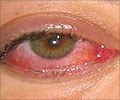A new study says that neither the age of the donor nor the length of time or method by which a transplanted cornea is preserved appear to be associated with graft failure 20 years after corneal transplant.
The report appears in the April issue of Archives of Ophthalmology, one of the JAMA/Archives journals. However, the diagnosis of the recipient does appear to be associated with this type of transplant failure.The number of corneal transplants in the United States increased 22 percent between 2006 and 2008, to almost 42,000 per year, according to background information in the article. "Consequently, the demand for donor corneal tissue has increased, and many surgeons, especially outside the United States, often have to accept tissue with longer preservation times or with lower preoperative endothelial cell densities [fewer endothelial (pump) cells, which are critical to long-term survival of the transplant] compared with previously," the authors write.
Sanjay V. Patel, M.D., of Mayo Clinic, Rochester, Minn., and colleagues examined the eyes of 388 patients periodically for 20 years after corneal transplant. Of these, 41 were available for analysis at the 20-year follow-up. Eighty-three of these corneal grafts were known to have failed, of which 26 were due to late endothelial failure, an increasing thickness and loss of clarity of the cornea with no identifiable cause.
Between the preoperative evaluation and 20-year follow-up, the endothelial cell density of the donor corneas had decreased an average of 74 percent; no additional cell loss occurred between 15 and 20 years of follow-up.
Transplant recipients with a diagnosis of keratoconus (a degenerative disorder in which the cornea becomes cone-shaped) had a lower risk of graft failure than those who had endothelial dysfunction (a decrease in the number or performance of endothelial cells). Donor tissue with lower endothelial cell density before surgery and higher endothelial cell loss at two months after transplant was associated with late endothelial failure among recipients with endothelial dysfunction but not keratoconus.
The time between donor death and corneal transplant was not associated with the risk of graft failure, nor was the method by which donor corneas were preserved during that time.
Advertisement
Advertisement
RAS










